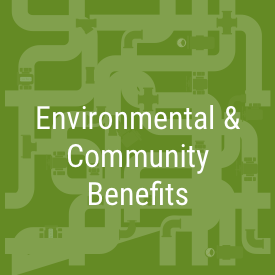This project supports Valley Water’s independent efforts and ongoing coordination with local cities and agencies to clean up trash, debris and hazardous pollutants generated by encampments near waterways or on Valley Water property. Such encampments contribute to contamination of waterways and damage to Valley Water facilities. This project includes cooperative efforts to partner with local municipalities and other agencies for services related to encampment cleanups and to help provide alternatives to homelessness.
This project will also provide funding for local municipalities’ services supporting staff safety as they work around encampments and discouraging re-encampments along waterways.








Fiscal Year FY24 (2023-2024), through Quarter 3 (July 1, 2023 – March 31, 2024)
- Valley Water managed 2,886.96 acres and removed 751.58 tons of trash, debris, and hazardous pollutants generated from encampments to reduce the amount of these pollutants entering streams.
- In FY24, through Q3, Valley Water provided $124,250 to San José Police’s Secondary Employment Program to support staff safety during encampment cleanups.
- In FY23, Valley Water signed an agreement with the County of Santa Clara (County) to provide outreach services to the unsheltered population residing on Valley Water lands and this effort continues in FY24. Under this Outreach Services Agreement, Valley Water will provide up to $200,000 each year to the County to coordinate and provide human services to unsheltered individuals residing on Valley Water-owned property along the waterways throughout the county. The County’s outreach service delivery will focus on, but not be limited to, areas outside of the City of San José.
Legal Constraints
Centers for Disease Control and Prevention (CDC) Guidelines: During the COVID-19 pandemic, the CDC issued interim guidance to public agencies, recommending they allow people who are living unsheltered or in encampments to remain where they are if no individual housing options are available due to the risk of spreading the disease. As of November 2022, this CDC guidance was updated to state that although people experiencing unsheltered homelessness do not reside in a congregate setting, the risk of severe COVID-19 can be high in this group because of underlying medical conditions and lack of access to healthcare.
Unhoused Case Law: Additionally, per the case of Martin v. Boise, in 2018 the U.S. Court of Appeal for the Ninth Circuit held that the City of Boise violated the Eighth Amendment of the U.S. Constitution (prohibiting cruel and unusual punishment) for enforcing two city ordinances that made it a misdemeanor to camp on streets, sidewalks, parks, or public places (camping ordinance), or to sleep in a public place without the owner’s permission (part of a disorderly conduct ordinance) when there was not enough beds available in local homeless shelters to house all of the unsheltered.
Effects of the Law on Valley Water
Both the case law and CDC guidance have significantly affected how public agencies like Valley Water are responding to encampments of unsheltered persons. These constraints also apply to city trail rules; so, while it is important to maintain public access to safe recreation opportunities, enforcement of these rules and ordinances on the unhoused community is subject to the limitations imposed by caselaw and statute.
Prior to the COVID-19 pandemic, Valley Water’s approach to encampment management was a complaint-driven, abatement-focused strategy. While this approach addressed the immediate location of an encampment, it rarely led to an outcome of fewer encampments, and often the encampment moved to a new location. The new encampment management strategy seeks to manage encampments by using a variety of tools and approaches to better manage sites and reduce the need for abatements overall until adequate housing is available.
April 2024
FY22-36 Key Performance Indicator for the Safe, Clean Water Program
-
Manage 300 acres annually to cleanup trash, debris, and hazardous pollutants generated from encampments and to reduce the amount of these pollutants entering streams.
-
Provide up to $500,000 per year in cost-share with local agencies for services related to encampment cleanups, including services supporting staff safety, discouraging re-encampments along waterways or addressing the socio-environmental crisis with the goal of reducing the need for encampment cleanups.
Benefits
-
Reduces the accumulation of trash, debris, and hazardous pollutants in local waterways, including streams, wetlands, and water utility facilities (e.g. percolation ponds)
-
Protects Valley Water facilities and reduces flood risk
-
Improves the aesthetics of creeks in neighborhoods and along trails
-
Coordinates Valley Water’s efforts with multiple agencies to create lasting solutions to reduce encampments near waterways
Geographic Area of Benefit
Countywide
About the Safe, Clean Water and Natural Flood Protection Program
In November 2020, voters in Santa Clara County overwhelmingly approved Measure S, a renewal of Valley Water’s Safe, Clean Water and Natural Flood Protection Program.
The program was first passed by voters in 2000 as the Clean, Safe Creeks and Natural Flood Protection Plan, then again in 2012 as the Safe, Clean Water and Natural Flood Protection Program. The renewal of the Safe, Clean Water Program will continue to provide approximately $47 million annually for local projects that deliver safe, clean water, natural flood protection, and environmental stewardship to all the communities we serve in Santa Clara County.
While evaluating ways to improve the 2012 program, Valley Water gathered feedback from more than 21,000 community members. That helped Valley Water create the six priorities for the renewed Safe, Clean Water Program, which are:
- Priority A: Ensure a Safe, Reliable Water Supply
- Priority B: Reduce Toxins, Hazards and Contaminants in our Waterways
- Priority C: Protect our Water Supply and Dams from Earthquakes and Other Natural Disasters
- Priority D: Restore Wildlife Habitat and Provide Open Space
- Priority E: Provide Flood Protection to Homes, Businesses, Schools, Streets and Highways
- Priority F: Support Public Health and Public Safety for Our Community
Each year, Valley Water prepares a report providing a progress update for each of these program priorities, along with fiscal year accomplishments.
To ensure transparency and accountability to the voters, the ballot measure also created an Independent Monitoring Committee, appointed by the Santa Clara Valley Water District Board of Directors. The Independent Monitoring Committee annually reviews the program’s progress to ensure the outcomes are achieved in a cost-efficient manner and reports its findings to the Board. Additionally, the IMC also reviews each proposed 5-year implementation plan prior to its submittal for Board approval.
In addition, the program requires three independent audits.


